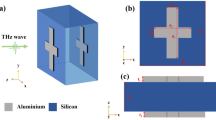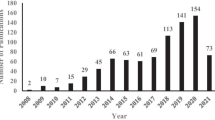Abstract
Metamaterial absorbers are increasingly studied and applied in sensing, telemedicine, and health monitoring applications. At present, many reported metamaterial-based sensors often exhibit the characteristics of single or multiple resonance modes. However, the sensing characteristics of these multi-mode metamaterial sensors are not independent. Here, a multi-mode metamaterial sensor (localized surface plasmon (LSP) resonance mode, dielectric loss mode) is measured and analyzed. In measurements, absorption peak P1 is sensitive to the thickness of the dielectric layer, while the absorption peak P2 is associated with lattice constant. The metamaterial sensor exhibits dual sensing capabilities for both temperature and sweat. When the metamaterial sensor is covered with sweat (the temperature remains unchanged), peak P2 is strengthened and moved to the low-frequency region, while peak P1 is basically unchanged. When the temperature is increased (the metamaterial sample is not covered by sweat), peak P1 is strengthened and moved to the low-frequency region, while peak P2 is basically unchanged. When the concentration components in sweat and temperature are increased synchronously, peaks P1 and P2 are increased simultaneously. Peak P1 is moved to the high-frequency region, while peak P2 is shifted to the low-frequency region. This proposed metamaterial sensor shows both independent and dual sensing properties.











Similar content being viewed by others
References
N. Engheta, Circuits with light at nanoscales: optical nanocircuits inspired by metamaterials. Science 317, 1698 (2007).
D.R. Smith, J.B. Pendry, and M.C.K. Wiltshire, Metamaterials and negative refractive index. Science 305, 788 (2004).
W. Cai and V.M. Shalaev, Optical Metamaterials: Fundamentals and Applications (Cham: Springer, 2009).
L.L. Huang, X.Z. Chen, H. Mühlenbernd, H. Zhang, S.M. Chen, B.F. Bai, Q.F. Tan, G.F. **, K.W. Cheah, C.W. Qiu, J.S. Li, T. Zentgraf, and S. Zhang, Three-dimensional optical holography using a plasmonic metasurface. Nat. Commun. 4, 2808 (2013).
X. Ni, A.V. Kildishev, and V.M. Shalaev, Metasurface holograms for visible light. Nat. Commun. 4, 2807 (2013).
K. Huang, Z.G. Dong, S.T. Mei, L. Zhang, Y.J. Liu, H. Liu, H.B. Zhu, J.H. Teng, B. Luk’yanchuk, J.K.W. Yang, and C.W. Qiu, Silicon multi-meta-holograms for the broadband visible light. Laser Photon. Rev. 10, 500 (2016).
S. Larouche, Y.J. Tsai, T. Tyler, N.M. Jokerst, and D.R. Smith, Infrared metamaterial phase holograms. Nat. Mater. 11, 450 (2012).
N.F. Yu, P. Genevet, M.A. Kats, F. Aieta, J.P. Tetienne, F. Capasso, and Z. Gaburro, Light propagation with phase discontinuities: generalized laws of reflection and refraction. Science 334, 333 (2011).
S.L. Sun, K.Y. Yang, C.M. Wang, T.K. Juan, W.T. Chen, C.Y. Liao, Q. He, S.Y. **ao, W.T. Kung, G.Y. Guo, L. Zhou, and D.P. Tsai, High-efficiency broadband anomalous reflection by gradient meta-surfaces. Nano Lett. 12, 6223 (2012).
Z.Y. Wei, Y. Cao, X.P. Su, Z.J. Gong, Y. Long, and H.Q. Li, Highly efficient beam steering with a transparent metasurface. Opt. Express 21, 10739 (2013).
C. Pfeiffer and A. Grbic, Metamaterial huygens’ surfaces: tailoring wave fronts with reflectionless sheets. Phys. Rev. Lett. 110, 197401 (2013).
J.B. Pendry, D. Schurig, and D.R. Smith, Controlling electromagnetic fields. Science 312, 1780 (2006).
M. Fridman, A. Farsi, Y. Okawachi, and A.L. Gaeta, Demonstration of temporal cloaking. Nature 481, 62 (2012).
N.F. Yu, P. Genevet, M. Kats, and F. Aieta, Light propagation with phase discontinuities: generalized laws of reflection and refraction. Science 334, 333 (2011).
N. Yu and F. Capasso, Flat optics with designer metasurfaces. Nat. Mater. 13, 139 (2014).
H. Wakatsuchi and C. Christopoulos, Generalized scattering control using cut-wire-based metamaterials. Appl. Phys. Lett. 98, 221105 (2011).
R.W. Ziolkowski, P. **, and C.-C. Lin, Metamaterial-inspired engineering of antennas. Proc. IEEE 99, 1720 (2011).
H. Wakatsuchi, S. Greedy, C. Christopoulos, and J. Paul, Customised broadband metamaterial absorbers for arbitrary polarisation. Opt. Express 18, 22187 (2010).
H. Wakatsuchi, J. Paul, and C. Christopoulos, Performance of customizable cut-wire-based metamaterial absorbers: absorbing mechanism and experimental demonstration. IEEE Trans. Antennas Propag. 60, 5743 (2012).
S. Kang, Z.Y. Qian, V. Rajaram, A. Alu, and M. Rinaldi, Ultra narrowband infrared absorbers for omni-directional and polarization insensitive multi-spectral sensing microsystems, in International Conference on Solid State Sensors Actuators and Microsystems, (Seoul, South Korea, 2005), pp. 886
H.J. Leea and J.G. Yook, Biosensing using split-ring resonators at microwave regime. Appl. Phys. Lett. 92, 254103 (2018).
S.B. Mbareka, S. Euphrasiea, T. Barona, L. Thiery, P.L. Vairac, B. Cretin, J.P. Guillet, and L. Chusseau, Room temperature thermophile THz sensor. Sens. Actuators A 193, 155 (2013).
Y. Shen, J.H. Zhou, T.R. Liu, and Y.T. Tao, Plasmonic gold mushroom arrays with refractive index sensing figures of merit approaching the theoretical limit. Nat. Commun. 4, 2381 (2013).
C.L. Gomez-Heredia, J.A. Ramirez-Rincon, D. Bhardwaj, P. Rajasekar, I.J. Tadeo, J.L. Cervantes-Lopez, J. Ordonez-Miranda, O. Ares, A.M. Umarji, J. Drevillon, K. Joulain, Y. Ezzahri, and J.J. Alvarado-Gi, Measurement of the hysteretic thermal properties of W-doped and undoped nanocrystalline powders of VO2. Sci. Rep. 9, 14687 (2019).
G.G. Zheng, P. Zhou, and Y.Y. Chen, Dynamically switchable dual-band mid-infrared absorber with phase-change material Ge2Sb2Te5. Opt. Mater. 99, 109581 (2020).
J. Kim, A.S. Campbell, B.E.F. de Avila, and J. Wang, Wearable biosensors for healthcare monitoring. Nat. Biotechnol. 37(4), 389 (2019).
A.J. Bandodkar, and J. Wang, Non-invasive wearable electrochemical sensors: a review. Trends Biotechnol. 32, 363 (2014).
Y. Lin, M. Bariya, and A. Jawey, Wearable biosensors for body computing. Adv. Funct. Mater. 31(39), 2008087 (2020).
Y.R. Yang, and W. Gao, Wearable and flexible electronics for continuous molecular monitoring. Chem. Soc. Rev. 48(6), 1465 (2019).
B.W. Zhong, K. Jiang, L.L. Wang, and G.Z. Shen, Wearable sweat loss measuring devices: from the role of sweat loss to advanced mechanisms and designs. Adv. Sci. 9, 2103257 (2021).
F. Poletti, B. Zanfrognini, L. Favaretto, V. Quintano, J. Sun, E. Treossi, M. Melucci, V. Palermo, and C. Zanardi, Continuous capillary-flow sensing of glucose and lactate in sweat with an electrochemical sensor based on functionalized graphene oxide. Sens. Actuators B 344, 130253 (2021).
J. Choi, R. Ghaffari, L.B. Baker, and J.A. Rogers, Skin-interfaced systems for sweat collection and analytics. Adv. Sci. 4(2), 3921 (2018).
H.Y. Nyein, M. Bariya, B. Tran, C.H. Ahn, B.J. Brown, W. Ji, N. Davis, and A. Javey, A wearable patch for continuous analysis of thermoregulatory sweat at rest. Nat. Commun. 12(1), 1823 (2021).
J. Chen, H.J. Zhang, G.Q. Liu, J.S. Liu, Y. Liu, L. Tang, and Z.Q. Liu, High-quality temperature sensor based on the plasmonic resonant absorber. Plasmonics 14, 279 (2019).
Y.F. Zhang, and M. Cui, Refractive index sensor based on the symmetric MIM waveguide structure. J. Electron. Mater. 48, 1005 (2019).
Y. Khannal, and Y.K. Awasthi, Dual-band microwave sensor for investigation of liquid impurity concentration using a metamaterial complementary split-ring resonator. J. Electron. Mater. 49, 385 (2020).
M. Bazgir, M. Jalalpour, F.B.B. Zarrabi, and A.S. Arezoomand, J. Electr. Mater. 49, 2173 (2020).
F. Chen, H.F. Zhang, L.H. Sun, J.J. Li, and C.C. Yu, Temperature tunable fano resonance based on ring resonator side coupled with a MIM waveguide. Opt. Laser Technol. 116, 293 (2019).
M.A. Baqir, A. Farmani, T. Fatima, M.R. Raza, S.F. Shaukat, and A. Mir, Nanoscale, tunable, and highly sensitive biosensor utilizing hyperbolic metamaterials in the near-infrared range. Appl. Opt. 57, 1 (2018).
A. Farmania, A. Mira, M. Bazgirb, and F.B. Zarrabi, Highly sensitive nano-scale plasmonic biosensor utilizing fano resonance metasurface in THz range: numerical study. Physica E 104, 233 (2018).
M.R. Rakhshani, and M.A. Mansouri-Birjandi, High sensitivity plasmonic refractive index sensing and its application for human blood group identifification. Sens. Actuators B 249, 168 (2017).
Acknowledgments
This research was financially supported by the Doctor’s Scientific Research Foundation (No. HZUBS201503), the Young and Middle Teachers’ Basic Ability Improvement Project of Guangxi (No. KY2016YB453).
Author information
Authors and Affiliations
Corresponding author
Ethics declarations
Conflict of interest
The authors declare that they have no conflict of interest.
Additional information
Publisher's Note
Springer Nature remains neutral with regard to jurisdictional claims in published maps and institutional affiliations.
Rights and permissions
Springer Nature or its licensor (e.g. a society or other partner) holds exclusive rights to this article under a publishing agreement with the author(s) or other rightsholder(s); author self-archiving of the accepted manuscript version of this article is solely governed by the terms of such publishing agreement and applicable law.
About this article
Cite this article
Li, Z., Zhong, M., Zang, L. et al. Dual-Mode Metamaterial Absorber for Independent Sweat and Temperature Sensing. J. Electron. Mater. 52, 4106–4116 (2023). https://doi.org/10.1007/s11664-023-10388-9
Received:
Accepted:
Published:
Issue Date:
DOI: https://doi.org/10.1007/s11664-023-10388-9




